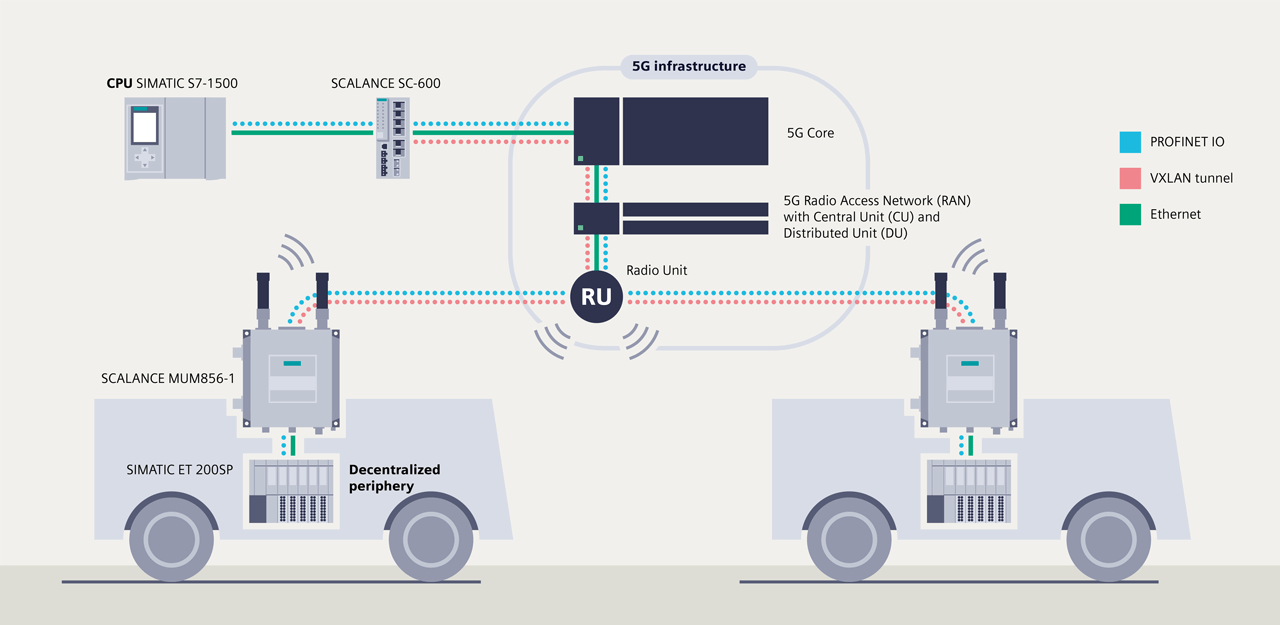ApplicationsSeptember 15, 2022
PROFINET communication in private industrial 5G networks

VXLAN is a protocol that embeds the logical Layer 2 communication in Layer 3 packets. This makes it possible to transmit Layer 2 protocols transparently across network boundaries, such as in routed Layer 3 5G infrastructures. This new approach is enabling use of PROFINET over private 5G industrial networks.
PROFINET communication has become an indispensable part of today’s automation technology. Many industrial applications require real-time transmission that the PROFINET standard offers. However, with the advent of 5G technology and its advance into industrial fields, users from the industrial environment are confronted with one difficulty: The currently available 5G technology cannot yet transmit PROFINET IO packets, which are necessary for the communication between a central controller and distributed I/O devices. This problem, though, can already be solved today using innovative communication technologies.
With 5G, a new mobile communications standard was developed for the first time that took into consideration industrial use cases – and it is already being used today in both public and private mobile communications networks. The 5G standard offers the possibility of adapting networks to different scenarios.

PROFINET communication over a private 5G network enables the use of a central controller for multiple mobile participants and significantly reduces energy and maintenance expenses.
The three main scenarios are: enhanced Mobile Broadband (eMBB), Ultra-Reliable Low-Latency Communication (URLLC), and massive Machine-Type Communication (mMTC). All scenarios serve different application areas: eMBB is bandwidth-oriented and URLLC supports the requirements of industrial IoT applications such as low latency with best possible reliability. MMTC is used for applications that require low power consumption and have a large number of connected devices.
Since a single wireless network cannot fully support all scenarios at the same time, i.e., maximum number of users and bandwidth with lowest latency, different typical 5G networks are emerging. One form of this are public mobile communications networks, in which the main scenarios eMBB and mMTC predominate to provide as much bandwidth as possible to many users for video telephony, video streaming, and other data-intensive applications.
However, these are less relevant requirements for industrial wireless networks, since industrial real-time protocols such as PROFINET IO rely on low latency and high reliability, as described by the URLLC scenario.
Private 5G networks for industrial real-time transmission

The SCALANCE MUM856-1 5G router from Siemens enables the transmission of PROFINET communication over 5G.
Reliability, latency, and control over a 5G network can be dramatically improved by companies establishing their own, local 5G networks and customizing them to meet the requirements of their mission-critical applications. For this purpose, the Bundesnetzagentur (German Federal Network Agency) has reserved part of the frequency spectrum for use in private, local 5G networks.
This spectrum can be requested for local use for a small fee. With these private 5G infrastructures, the available spectrum can be used exclusively, which has a positive effect on the performance of the network and, for example, enables time-critical applications.
The 5G technology standard currently available on the market corresponds to 5G Release 15. A current challenge here is that important elements such as the URLLC standard will only be introduced in the future with Release 16. However, companies are already working with private 5G networks today to take advantage of their benefits – and would also like to use them for their industrial real-time protocols such as PROFINET IO. In doing so, they are faced with a challenge since the current Release 15 infrastructure cannot transmit the Layer 2 communication of the OSI layer model, which is frame-based. Only the layer above, Layer 3 with data packets (TCP and UDP), is supported.
This makes it possible, e.g., to access internal configuration web pages, for instance the web-based management of devices, or to establish OPC UA or MQTT communication. However, one of the currently most widely used fieldbus systems, PROFINET IO, cannot be used natively with this because it requires a Layer 2 connection, which will only be supported in the 5G standard with Release 16.
New approach enables PROFINET communication over 5G
However, PROFINET IO can already be used in private 5G networks today by means of innovative transmission technologies, as utilized, for example, in the SCALANCE products from Siemens. This is achieved by using the VXLAN (Virtual Extensible LAN) protocol. VXLAN is a protocol that, in simplified terms, embeds the logical Layer 2 communication in Layer 3 packets. This makes it possible to transmit Layer 2 protocols transparently across network boundaries, such as in routed Layer 3 5G infrastructures.
This approach opens up completely new possibilities. For example, several automated guided vehicles (AGVs) can be controlled centrally with one SIMATIC S7-1500 controller. PROFINET IO is used as the protocol between the SIMATIC S7-1500 and the SIMATIC ET 200SP distributed I/O devices on the AGV. At the heart of the communication is a private Release 15 5G infrastructure to which the SCALANCE MUM856-1 5G routers are connected. The infrastructure consists of the 5G core, which manages the entire network and the data traffic, the central unit (CU), which manages the wireless network, the distributed unit (DU), which processes the digital wireless signal, and the radio unit (RU), which transmits the wireless signal via antennas.
VXLAN enables the necessary transmission of PROFINET IO packets
The special feature of this network, however, is that there is a VXLAN tunnel between the SCALANCE MUM856-1 5G router and a SCALANCE SC-600 security firewall, which is placed between the controller and the 5G core. The two devices encapsulate and decapsulate the PROFINET packets with the aid of VXLAN – thus enabling the wireless PROFINET communication between the controller and the distributed I/O devices. However, this “tunnel” should not be confused with classic VPN tunnels, since no additional encryption is performed here by the VXLAN protocol – only the transmission of the packets takes place.
By means of the VXLAN tunnel, the two AGV networks with the ET 200SPs and the central S7-1500 controller are in the same virtual Layer 2 network and, for the first time, the PROFINET IO protocol or other Layer 2 protocols can be used for the communication over a 5G network. It should be noted here that, similar to other wireless technologies, the update times and retransmission repetitions of PROFINET IO packets must be adapted to the performance of the wireless network (the 5G infrastructure) to maintain deterministic and real-time capability. As 5G releases progress, the performance will continue to improve with, for example, URLLC extensions.
Significant reduction of energy and maintenance expenses thanks to central controller
By using central PROFINET IO communication, a distributed I/O device can be used on the AGV and there is no need for a local controller. This result in space, cost, energy and, maintenance savings. By means of a controllable digital output of the SCALANCE MUM 5G router, the entire AGV can be switched currentless via a separate relay to save energy during idle times.
For longer planned downtimes, the 5G router can also be put into a deep sleep mode, in which power consumption drops to an absolute minimum. This means that power consumption can be reduced even during longer downtimes, such as on weekends, thus increasing the battery charge of the AGV. The advantages of the current implementation using VXLAN are clear and show that powerful industrial protocols such as PROFINET IO can already be operated in today’s private 5G networks within the given framework conditions.


